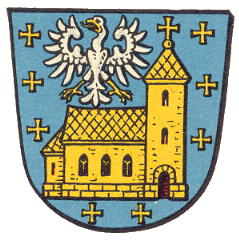Monsheim: Difference between revisions
Knorrepoes (talk | contribs) No edit summary |
Knorrepoes (talk | contribs) No edit summary |
||
| Line 9: | Line 9: | ||
State : [[Rheinland-Pfalz]]<br/> | State : [[Rheinland-Pfalz]]<br/> | ||
District (Kreis) : [[Alzey-Worms]] (until 1969 Worms)<br/> | District (Kreis) : [[Alzey-Worms]] (until 1969 Worms)<br/> | ||
Additions : 1969 [[Kriegsheim]]<br /> | Additions : 1969 [[Kriegsheim (Alzey-Worms)|Kriegsheim]]<br /> | ||
Verbandsgemeinde : [[Verbandsgemeinde Monsheim]] | Verbandsgemeinde : [[Verbandsgemeinde Monsheim]] | ||
Revision as of 07:26, 7 December 2013
| Heraldry of the World Civic heraldry of Germany - Deutsche Wappen (Gemeindewappen/Kreiswappen) |
MONSHEIM
State : Rheinland-Pfalz
District (Kreis) : Alzey-Worms (until 1969 Worms)
Additions : 1969 Kriegsheim
Verbandsgemeinde : Verbandsgemeinde Monsheim
Official blazon
In geteiltem Schild oben in Rot ein goldenes Kreuz, unten in Blau ein rotbewehrter silberner Adler.
Origin/meaning
The arms were granted on December 28, 1957.
The oldest seal of the town dates from 1523, but the oldest remaining seal dates from 1598. It showed a shield with a cross, and with small crosses in the different quarters. This cross was the arms of the Lords of Westerburg, rulers of the town at the time. The second seal, known since 1690, shows the arms of the, now, Counts of Leiningen-Westerburg, with in the first and fourth quarter the eagle of the Counts of Leiningen, and in the second and third quarter 5 small crosses, derived from the Westerburg arms. As supporter the local patron saint, St. Pirminius, was used, holding in his free hand a model of the local church. Later seals show either only the patron saint, or the same composition as above.
The municipality adopted the arms above, which combine the eagle and cross of Leiningen and Westerburg.
In 1956 the arms below were proposed:
In this proposal the shield with the crosses from the Westerburg arms was taken, with the eagle and blue background of Leiningen and the church as the symbol of the patron saint. The proposal thus combined elements from the different seals and arms.
Literature : Lehmann, 1960; Hessisches Wappenbuch, 1956


